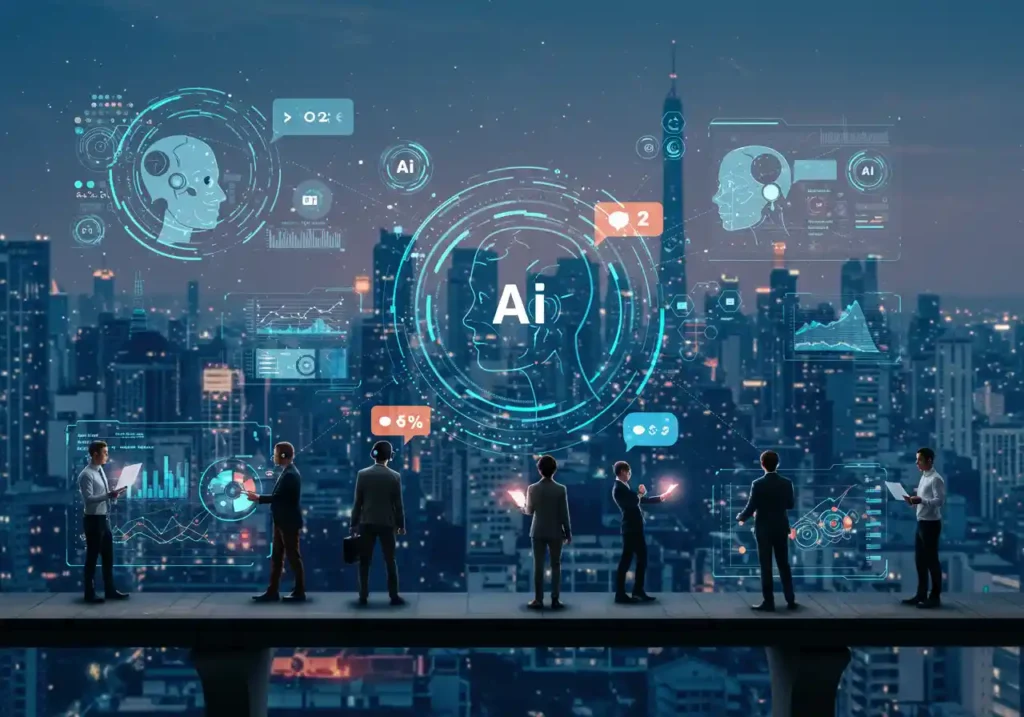How AI is Impacting Sales & Marketing in 2025
AI in Sales and Marketing is not the future. It’s now! It’s already reshaping business operations in Kenya across various industries — including telecommunication, banking, and legal services. Businesses that embrace AI are outperforming those that don’t, not because they are working harder — but smarter.
The message is clear: adapt now or risk becoming obsolete. It’s time that we move beyond curiosity and start leveraging AI to gain a competitive edge. In this blog, we explore how AI is impacting sales and marketing, and what companies need to do to stay ahead.
Ways AI is Being Used in Sales & Marketing
AI adoption in sales and marketing is increasing rapidly. 33% of medium to large businesses in Kenya have implemented AI, with another 41% planning to implement it within the next two years. Sales and marketing teams are using AI to automate tasks, make data-driven decisions, and to personalize customer experiences.
-
Automation of Tasks
Automation is the use of technology to perform tasks with minimal human intervention. Sales and marketing teams are using AI to automate repetitive and time consuming tasks such as sending follow-up emails, updating CRM systems, and handling customer queries. This allows the teams to focus more on strategic work that adds greater value.
Safaricom, for example, uses an AI-powered chatbot (Zuri) to handle frequently asked questions and provide immediate support 24/7.
-
Customer-Centric Personalization
AI can be used to tailor messages, product recommendations, and services to individual users based on their preferences and behaviors. They analyze data from their purchase history, browsing history, demographics, social media interactions and identify patterns. This leads to:
- Increased customer satisfaction and retention.
- Higher conversion rates.
- Enhanced customer experience and engagement.
- Optimized marketing efforts.
Jumia, for example, uses AI to analyze their user’s browsing history and purchase history to offer personalized product suggestions.
-
Lead Generation & Nurturing
Lead generation involves attracting prospects to your business and nurturing their interest in a product or service with the end goal of converting them into a paying customer.
AI tools such as HubSpot analyses historical data and real-time interactions to predict which leads are most likely to convert. Scores or ranks are then assigned to the leads based on their demographics, behaviors, and engagements. This helps sales and marketing teams to focus their efforts and resources on the most promising prospects.
-
Sales Forecasting
AI can be used to analyze large datasets to identify patterns that may not be obvious and be used to forecast future events and outcomes. This enables sales and marketing teams to gain insights into customer behaviors, sales patterns, and market dynamics, and be able to make data-driven decisions, anticipate demand, and mitigate risks.
AI Tools Used in Sales & Marketing
Some of the AI tools used by sales and marketing teams include:
- Zapier: Used to automate repetitive and time consuming tasks.
- Jasper: A content creation tool that helps businesses generate high-quality content easily such as blog posts, product descriptions, social media copy, website content, marketing copy and so much more.
- Saleshandy: Helps in automating your outreach by delivering highly personalized cold emails directly to your prospects.
- HubSpot: Used for automation of tasks, CRM optimization, personalized marketing, and chatbots and virtual assistants.
- Microsoft Clarity: Helps you to understand how users are interacting with your website. This gives you insights on how to optimize user experiences and ultimately improve conversion rates.
What Corporate Leaders Must Know about AI in Sales and Marketing?
AI is not optional. If you haven’t begun actively integrating AI into your business operations, you’re already playing catch up.
The industry is changing. Will AI take your job? No. But those who know how to use AI will. If you want to future-proof your career, it’s important that you learn how to use AI.
How You Should Feel About The Emerging Trend of AI in Sales and Marketing
We don’t want to sell you fear. We want to spark urgency, and most importantly, confidence. Confidence that AI is within reach. You can take actionable steps right now to harness the power of AI to gain a competitive edge.
How to Start Using AI in Sales and Marketing
If you’re looking to stay competitive in 2025, here’s a structured approach on how to start integrating AI into your workflows to increase productivity, efficiency, and boost your overall performance:
-
Identify Key Use Cases
Identify areas in your operations that you can leverage the use of AI such as automation of tasks, lead generation and nurturing, content creation, predictive analytics, and campaign optimization.
-
Select the Right AI Tools
Based on your specific needs, choose the AI tools that would help you in achieving those needs. You can use AI tools such as chatbots and virtual assistants for handling customer queries, Jasper for content creation, and HubSpot for automation of tasks.
-
Train Your Team
Train your sales and marketing team on how to use AI tools effectively and efficiently. Invest in short courses that provide hands-on training such as our 2-Day Hands-On AI Training Course to help in upskilling your team.
-
Implement AI gradually
Start small. Don’t try to implement AI in everything at once. Start with one area like automating repetitive tasks. Continuously measure and evaluate the performance and then adjust strategies based on results.
-
Scale what works
Once you see results, expand to more functions such as personalization, predictive analytics, and lead scoring.
Choose to lead and not lag. Embrace AI today and unlock its power in your business.


